California Boating and Waterways Commission Meets in Modesto, Tours Dos Rios Ranch and Grant Projects Sites
Story and photos from: Kevin Murphy, Communications and Marketing Division
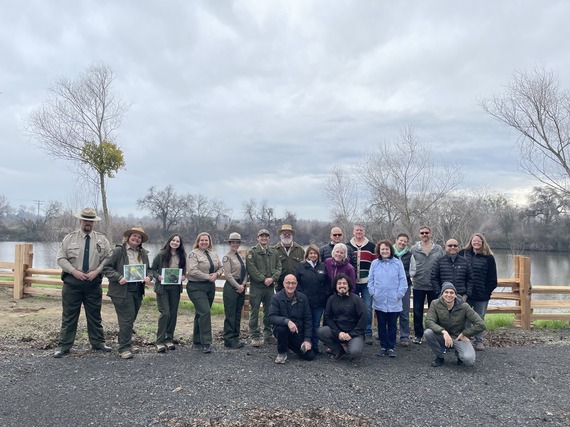 Members of the California Boating and Waterways Commission and State Parks staff visited Dos Rios Ranch prior to the Commission’s meeting. Front row, kneeling (left to right): State Parks Director Armando Quintero, Commissioner Jose Gonzalez and David Klosinski, Division of Boating and Waterways (DBW). Second row, standing (left to right): DBW Deputy Director Ramona Fernandez, Commissioner Katie Hawkins and Kathryn Tobias, State Parks senior legal counsel. Back row, standing (left to right): Duke Heberling, Four Rivers sector superintendent; Caitlin Jackson, interpreter II; Ali Manzo, interpreter I; Paige Haller, Dos Rios park manager; Danielle Gerhart, Central Valley District superintendent; Julian Morin, senior park aide; Josh Thompson, park maintenance supervisor; Commissioners Kenneth Ehrman and Tom Pier; and Keren Dill, Casey Caldwell, Joe Dux and Courtney Ferris, DBW.
Occasional rain may have dampened their clothing, but not the spirits of State Parks staff, members of the public and the California Boating and Waterways Commission (Commission) during a recent tour of three sites in Stanislaus and Mariposa Counties on Wednesday, February 7. Visits to Dos Rios Ranch, Tuolumne River Regional Park and Lake McClure preceded the Commission’s first meeting of 2024 held in Modesto, California, on Thursday, February 8.
Located at the confluence of the San Joaquin and Tuolumne Rivers, Dos Rios Ranch is being staged for its introduction as California’s newest state park. New shade ramadas, picnic tables, fencing, trails and American With Disabilities Act-accessible pathways have appeared in anticipation of opening later this year on a limited basis. The park will not only provide recreational opportunities for underserved communities throughout the Central Valley, but new habitat for returning species, including several on the state’s threatened and endangered species list.
In nearby Modesto, the tour paused to view a nearly completed nonmotorized boating ramp and parking lot in Tuolumne River Regional Park. With initial funding through a $750,000 grant from the Division of Boating and Waterways, the new ramp will allow recreational users additional access to the Tuolumne River and provide emergency personnel with another point to launch watercraft needed in first-response situations. A final stop was included at Lake McClure, in the foothills of Mariposa County, managed by the Merced Irrigation District. Since 2007, because of low lake levels due to environmental conditions, two boat ramps used to provide water access remain out of the water an average of 59% of each year. A $400,000 planning grant, later approved during the Commission meeting in Modesto, will provide initial funding needed to extend the ramps. Like other parks in the region, many users come from underserved communities in the Central Valley.
The agenda for the Commission meeting included staff updates for communication and marketing and division program reports, including the Surrendered and Abandoned Vessel Exchange Program, Boating Safety and Enforcement Equipment Grant Program and Quagga and Zebra Mussel Infestation Program. The Commission also approved the planning grant for Lake McClure and reelected Chairperson Katie Hawkins and Vice Chairperson Tom Pier. A recording of the Commission meeting can be found on CAL-SPAN.org, and information on previous meetings are available on the Commission webpage.
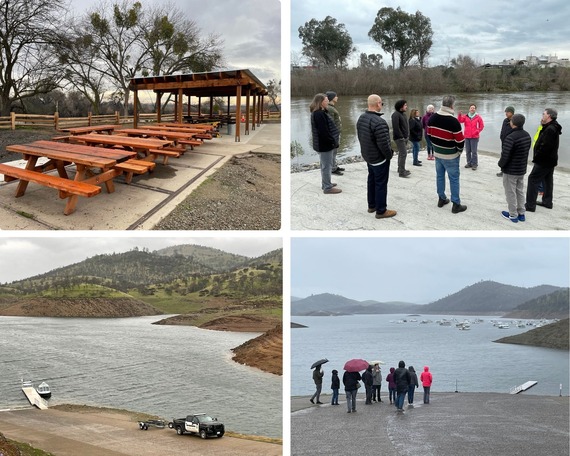 Top left: New picnic tables and shade ramadas are ready for visitors at Dos Rios Ranch, expected to open on a limited basis later this year. Top right: Tour participants meet at the end of a new nonmotorized boat ramp at Modesto’s Tuolumne River Regional Park. Bottom right: A planning grant to extend boat ramps and expand aging facilities was approved by the Commission for Lake McClure. Bottom left: Longer ramps will provide better access for recreational users, as well as first responders from the Mariposa County Sheriff’s Office.
Anza-Borrego Desert State Park Paleontology Society Leads New Group of Volunteers on Search for Fossils
Story from: Harrison Sturgeon and Tabbatha Ostlie, Colorado Desert District
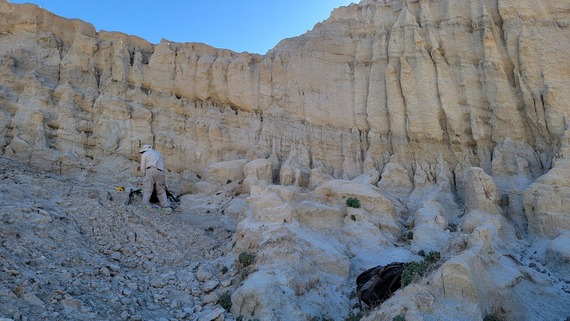 Gomphothere site excavation. We focus on smaller areas and dig down to a layer we understand contains fossils. Layers are distinguished by color, hardness and position. Photo from Harrison Sturgeon, Colorado Desert District.
The Anza-Borrego Desert State Park Paleontology Society Volunteer Certification Program is in full swing, as this season's class headed into the field for the first time for the 2023-24 winter volunteer season. On Dec. 1, 2023, Colorado Desert District Environmental Scientist and District Paleontologist Dr. Lyndon Murray and I, Environmental Services Intern Harrison Sturgeon, led a group of new volunteers into the field to teach them about the geology, stratigraphy and paleontology of the area.
Fossils are normally difficult to distinguish except by persons with specific knowledge and training, and require protection from damaging influences. After a pleasant hike up the wash and a thorough explanation of proper field procedures, the class members dispersed to search for fossils on their own. In an unexpected but welcome turn of events, every member of the group found a specimen. Some highlights include an Antilocapra vertebra and a Canid humerus, or a pronghorn and wolf fossil, respectively. It is important to note that while it is exciting to find a fossil, each field trip is meticulously planned through the state’s approval to ensure park resources are protected. Confidentiality in these fossil localities is important in protecting fossils from harm, theft or destruction.
A second, more experienced group of volunteers also explored an area further up the wash for fossils. They were led by volunteer Field Leader Ralph Davis and Senior Park Aide Arnie Mroz. The experienced group found a stellar specimen identified on site as a Camel metapodial, or an ankle fossil. The specimen was left in the field for now due to its large size, but plans have been made to bring protective jacketing materials and retrieve it at a later date.
The ongoing gomphothere (large elephant-like animals with shovel tusks) fossil dig site has seen more excavation in the past few weeks, especially now with the winter volunteer season in motion. Field trips happen every Tuesday, and there is always something exciting to do, whether it is digging into the fossiliferous layer or searching through the debris for any fossils, large or small. While there have been gomphothere fossils, the site has a large diversity of animals, ranging from birds to reptiles, to even a large deer.
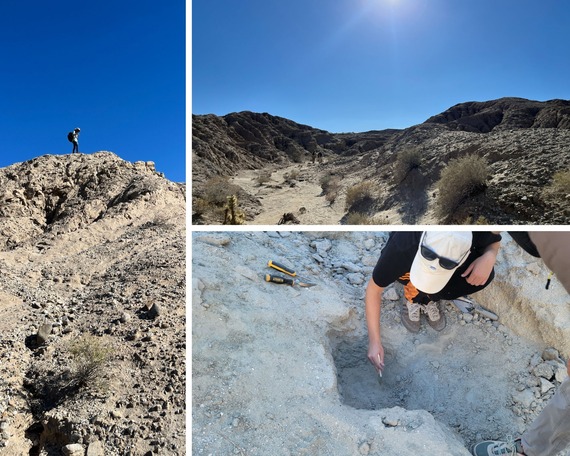 Left: A member of the certification class enjoying the view. Top right: Dr. Lyndon Murray heading the pack. Bottom right: An environmental services intern carefully digging a survey pit to find fossiliferous layers. Photos from Harrison Sturgeon, Colorado Desert District.
Unique Perspective of Historic China Camp Village at China Camp State Park
Story and photos from: Dana Richards, Bay Area District
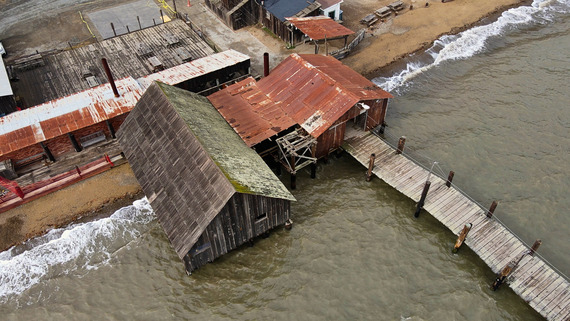 An aerial image of China Camp Village.
Researchers teamed up with State Parks in November 2023 to capture images of China Camp Village at China Camp State Park from the sky using unmanned aerial vehicles, or drones. The team included California State University, Sonoma, cultural resources management graduate students Senior Park Aide Dana Richards and James Hercher, along with their advisor and lead archaeologist Mike Konzak and State Parks Historian III/Cultural Resources Program Manager Noah Stewart.
In addition to drone footage, cellular devices were used to capture images of the village from the ground level. The tens of thousands of images collected were processed to construct a virtual 3D model of the historic site by the researchers.
Drone imagery and 3D modeling are two technologies archaeologists and cultural resource managers are increasingly utilizing to aid in restoration, preservation and interpretation. The 3D models can be used as a detailed record that illustrates the current conditions and accurate measurements of a site. This technology also enables park staff to revisit the site multiple times without traveling to the site.
This research, along with the 3D model, will be presented during one of the poster sessions at the Society of California Archaeology’s annual meeting in March.
Please note that drones are not permitted to be flown in state parks unless the flight has been approved by the State Parks permitting process with appropriate Federal Aviation Administration registration.
 Aerial image of researchers and State Parks staff at China Camp Village.
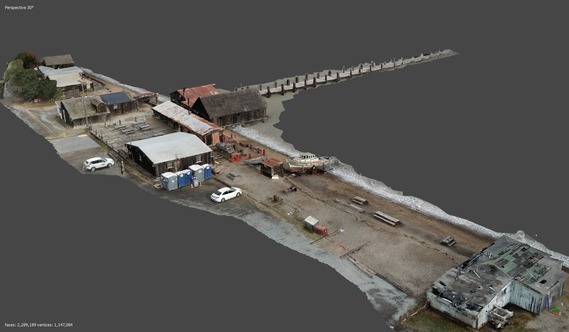 Screen capture of virtual 3D model of China Camp Village.
Sonoma State Historic Park Launches Mission Minecraft Project
Story from: S. Tyler Markley and Brooke Sullivan, Bay Area District
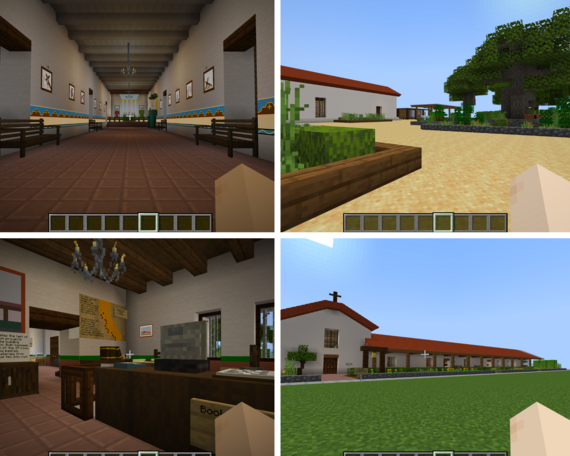 Screenshots of the Minecraft version of San Francisco Solano Mission. Photos from Brooke Sullivan, Bay Area District.
We are excited to announce the completion and launch of a free educational Minecraft server, providing an opportunity for kids of all ages to take a virtual tour of the San Francisco Solano Mission located at Sonoma State Historic Park (SHP).
The Minecraft video game is akin to a digital set of Legos, allowing you to unleash your imagination. Picture a vast world made of blocks where you can construct anything from simple houses to entire virtual cities, and in our case, a historic California mission.
Minecraft serves as a virtual community where people come together to create, explore and share their experiences. In the United States alone, there are over 4,000 servers, essentially different spaces within the game where people can connect and play together. Given these facts, we felt it would be a disservice not to try and offer a new and accessible avenue to share our park's history with the public.
The overall goal of this project is to provide kids with an engaging platform to delve into California history. It also offers access to those who may not be able to visit the mission in person. The project marks a notable leap in educational innovation for State Parks. As the first California state park to embrace Minecraft as an educational tool, Sonoma SHP aims to pave the way for a new form of interactive and engaging learning experiences that we hope to see spread across the state.
Our project aligns perfectly with the core principles of the California State Parks mission. By preserving our state's extraordinary cultural resources and creating innovative opportunities for education and recreation, we are staying true to our commitment to inspire and educate the people of California. Creating this project has been an incredibly rewarding and fulfilling experience. We hope that people will enjoy and benefit from the hard work and dedication poured into this project.
We invite everyone to embark on a virtual journey through the San Francisco Solano Mission. For any inquiries or to express your interest, do not hesitate to reach out to us at SonomaMissionMinecraft@gmail.com. We look forward to welcoming you to this unique educational experience!
State Parks Staff Converge Upon King of the Hammers 2024
Story from: Luke Ware, Off-Highway Motor Vehicle Recreation Division
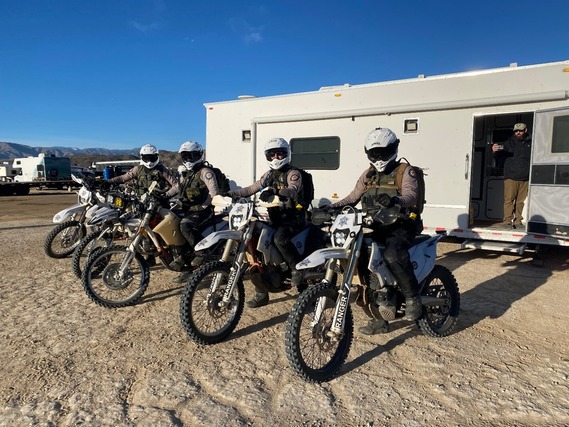 State Parks trailer with officers ready to go on patrol. Left to right: State Park Superintendent (SPS) II Luke Ware, SPS III Andrew Ahlberg, Sgt. Dennis Burden, SPPO Jesse Norton and Associate Park and Recreation Specialist Josh Bernadas. Photo from Jack Gorman, Off-Highway Motor Vehicle Recreation Division.
King of the Hammers, which took place from January 29 to February 3, is an annual motorsport competition spanning a two-week period in the Johnson Valley Off-Highway Vehicle (OHV) Area. Roughly 85,000 spectators and racers get involved each year in the event, which is held on both public lands managed by the Bureau of Land Management and military property known as Marine Corps Air Ground Combat Center (MCAGCC) 29 Palms. Much of the activity is based out of “Hammertown,” the name of the minicity created on Means Dry Lake each year. Spectators and competitors move about Hammertown, checking out OHV-centered and food vendors, as well as watching one of the many jumbotron screens that bring the action from the desert to Hammertown.
Local, state and federal agencies work together with the event organizers to ensure a smooth and safe event. Experienced state park peace officers (SPPOs) trained in OHV use are specifically requested to work at the event. With their specialized equipment and training, SPPOs on motorcycles and recreational OHVs can cover ground that typical law enforcement cannot, ensuring both public safety and natural resources protection. SPPOs assigned to the King of the Hammers work directly with event staff, U.S. Marine Corps (USMC) personnel and Bureau of Land Management to keep spectators off the active racecourses and the MCAGCC, which is used for live fire training on a regular basis. California Highway Patrol and San Bernardino Sheriff’s Office are also heavily involved, and all the participating law enforcement agencies and USMC staff met daily to ensure event objectives were met.
 Top of Rodman Mountain, looking east across Johnson Valley OHV Area and MCAGCC 29 Palms. Left to right: Sgt. Dennis Burden, SPPO Ric Hansen, SPPO Jesse Norton, SPPO Derek Donaldson, SPPO Jeremy Black, SPS II John Cunningham, SPS II Luke Ware, SPS III Andy Ahlberg, SPPO Brandon Champieux and SPPO Tim Schulte. Photo from Andrew Ahlberg, Off-Highway Motor Vehicle Recreation Division.
Antelope Valley California Poppy Reserve State Natural Reserve Welcomes New Docents
Story from Callista Turner, Great Basin District
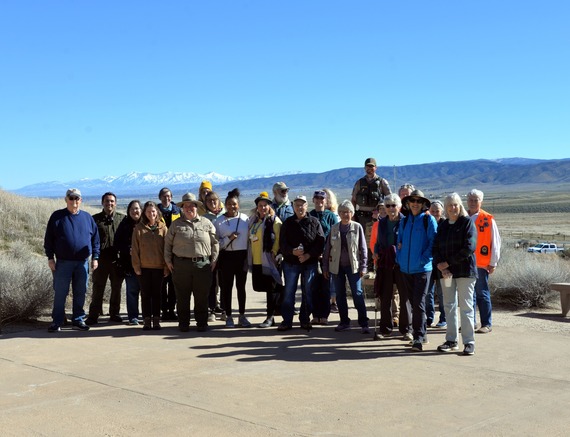 New park docents with Interpreter I Callista Turner at the reserve. Photo from John Martin, volunteer and Poppy Reserve Mojave Desert Interpretive Association member.
The Antelope Valley California Poppy Reserve State Natural Reserve welcomes its newest docents to the team. Every year, thousands of visitors come to explore the wonders of the reserve, and the docent program is an essential part of our operations.
After several days of training—and a bountiful potluck—our new docents are eager to enrich this year’s visitor experience. Opportunities and trainings like this are possible only through State Parks’ collaboration with both our volunteers and the Poppy Reserve Mojave Desert Interpretive Association.
We are looking forward to a bright season and cannot wait to see all our new docents bloom!
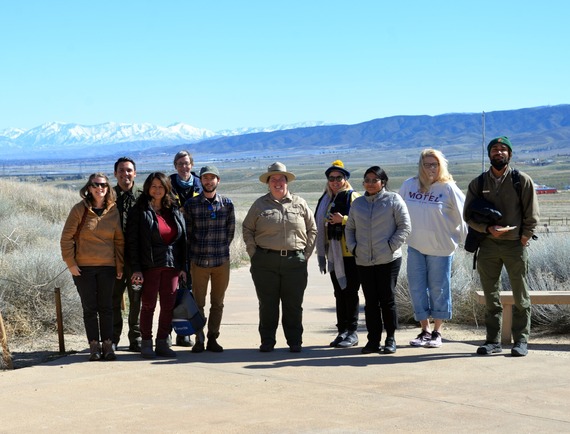 Other new park docents with Interpreter I Callista Turner. Photo from John Martin, volunteer and Poppy Reserve Mojave Desert Interpretive Association member.
 PARTNER NEWS
Announcing the 2024 Adventure Pass Grants Program
Story from: Amanda Zhu, Parks California
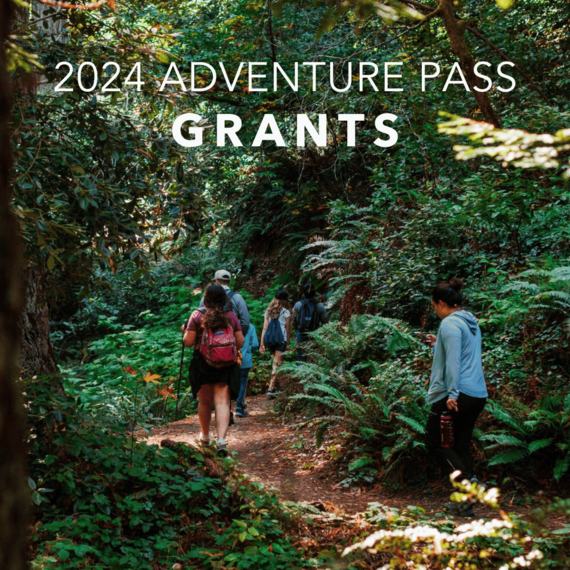 Parks California, in partnership with California State Parks, is excited to announce our 2024 Adventure Pass Grants Program to help more fourth graders and their families take advantage of the California State Park Adventure Pass. We believe every child should have easy access to parks, and this grant program is one of the ways we are working to make that possible.
The California State Park Adventure Pass Program recently almost tripled the number of park locations, expanding from 19 to 54 participating state parks. This means more opportunities for learning, fun and sparking curiosity.
Parks California is now accepting submissions until Monday, March 25, 2024, from nonprofit and community organizations that can provide transportation and meaningful, relevant outdoor experiences for fourth graders and their families. Details about the program’s grant eligibility, deadline and application process are available now and can be found here.
To help with the application process, Parks California staff will host an informational webinar on Thursday, February 29, at 9 a.m., to review the grant application process and answer any questions. RSVP to the webinar by clicking here.
  Email photos to the WeeklyDigest@parks.ca.gov.

|